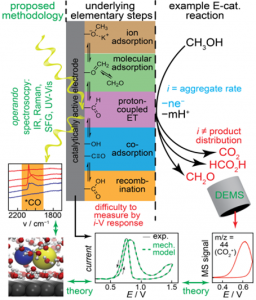Motivation: The efficient interconversion of electrical and chemical energy requires functional electrodes that are able to catalyze complex multi-electron energy conversion reactions. The electrodes in energy conversion devices must, therefore, serve not merely as inert sources or sinks of electrons but rather as active players that bind  reactants, stabilize key intermediates, and enable inner-sphere electron transfer (ISET) reactions. Despite its fundamental and technological importance, a molecular-level mechanistic understanding of the factors that drive efficient multi-electron inner-sphere electrocatalysis remains elusive, impeding systematic progress toward innovative and more efficient energy conversion technologies. This critical knowledge gap arises because the current-voltage response of an electrode provides little information about the complex array of elementary surface processes that underpin near all energy conversion reactions. Addressing this longstanding grand challenge requires multi-faceted methodologies that go beyond classical current-voltage measurements and combine operando probes and atomistic simulations to develop multiscale models of critical ISET reactions.
reactants, stabilize key intermediates, and enable inner-sphere electron transfer (ISET) reactions. Despite its fundamental and technological importance, a molecular-level mechanistic understanding of the factors that drive efficient multi-electron inner-sphere electrocatalysis remains elusive, impeding systematic progress toward innovative and more efficient energy conversion technologies. This critical knowledge gap arises because the current-voltage response of an electrode provides little information about the complex array of elementary surface processes that underpin near all energy conversion reactions. Addressing this longstanding grand challenge requires multi-faceted methodologies that go beyond classical current-voltage measurements and combine operando probes and atomistic simulations to develop multiscale models of critical ISET reactions.
 MURI Team: The proposed MURI program is a multidisciplinary effort aimed at developing a molecular- level understanding of the fundamental processes that drive complex electrochemical reactions. This research will be carried out as a collaborative effort between Emory University (T. Lian, Lead PI), Cornell University (H. D. Abruña), Massachusetts Institute of Technology (Y. Surendranath and A. Willard), University of Pennsylvania (J. Subotnik), University of Southern California (J. Dawlaty), and Yale University (S. Hammes-Schiffer and J. Mayer).
MURI Team: The proposed MURI program is a multidisciplinary effort aimed at developing a molecular- level understanding of the fundamental processes that drive complex electrochemical reactions. This research will be carried out as a collaborative effort between Emory University (T. Lian, Lead PI), Cornell University (H. D. Abruña), Massachusetts Institute of Technology (Y. Surendranath and A. Willard), University of Pennsylvania (J. Subotnik), University of Southern California (J. Dawlaty), and Yale University (S. Hammes-Schiffer and J. Mayer).
Mission Statement: Advance molecular-level understanding of fundamental interfacial electrochemical structures, processes and catalytic reaction by developing novel multimodal operando experimental probes and comprehensive computational tools and by addressing long-standing challenges in surface electrocatalysis
Thrust Areas: The proposed MURI program contains five closely integrated Thrusts (see research link for details).
Anticipated Outcome: The anticipated outcome of this MURI program will be a transformative molecular-level understanding of electrochemical phenomena, as well as widely accessible multimodal experimental platforms and advanced theoretical tools for understanding, optimizing, and designing next generation electrochemical technologies that are essential to DoD missions.

